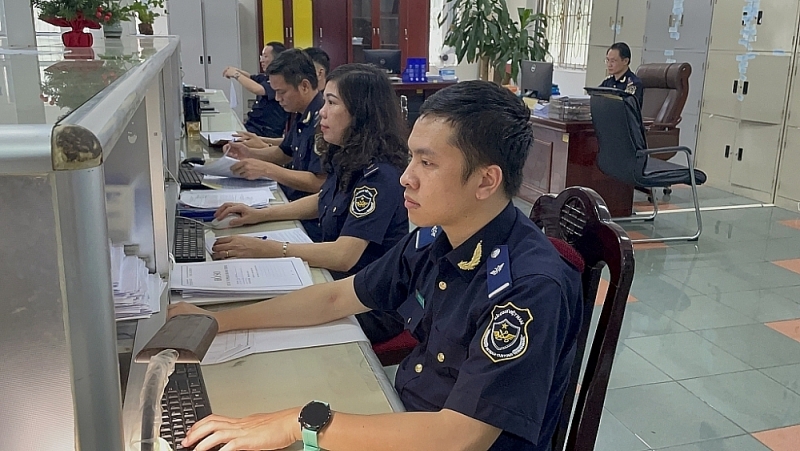 |
| Professional activities of officers of Phu Tho Customs Branch (Hanoi Customs Department). Photo: N.Linh |
Promote connection, information sharing
According to Deputy Director of the Customs Supervision and Administration Department (General Department of Customs) Dao Duy Tam, in the draft circular amending and supplementing Circular 38/2015/TT-BTC and Circular 39/2018/TT- BTC, the drafting committee continued to implement the direction of the General Department of Customs, especially Directive 384/CT-TCHQ of the Director General of the General Department of Customs on promoting administrative reform and simplifying customs procedures, towards paperless customs in 2022.
In the process of revising and reviewing the contents, the Drafting Board found that currently in the customs dossier, there are only two types of documents, which are specialized licenses as prescribed by some ministries, which have not been implemented on the single window but still carry out procedures and certificates of origin of goods as committed and have not yet implemented digitization. For the instructions related to building a Circular towards going paperless and digitizing documents in customs dossiers, the Customs authority shall thoroughly apply regulations related to documents when carrying out customs procedures and other administrative procedures.
This draft also promotes the exchange, connection and sharing of customs dossier information with ministries, branches and businesses to reduce administrative procedures. For example, the detailed declaration of chassis number, engine number and type of road transport vehicle such as motorcycles or cars. The detailed declaration of information contributes to providing declaration information for relevant agencies to carry out vehicle registration procedures, thereby contributing to the abolition of the procedure for certifying the origin declaration.
According to the leader of the Customs Supervision and Administration Department, regarding the final settlement report on the situation of raw materials for processing and production for export, the draft Circular to encourage businesses to connect directly with the Customs authority must submit a paper finalization report according to the fiscal year, the customs authority will directly use the data provided by the enterprise online to check the finalization report.
With the application of automatic monitoring, the draft Circular continues to maintain connections and share information with port and warehouse businesses such as customs declaration information, the status of Customs declarations that are cleared or stored, or customs sealed so that warehouse and yard businesses can take measures on behalf of the Customs to carry out supervision measures to bring goods out of the customs area.
In addition, Customs continues to promote the implementation of administrative procedures on the national public service portal, such as administrative procedures related to means of transport on exit and entry; other administrative procedures that at present are not possible to build a new system for implementation.
Simultaneously, electronic information exchange transactions between Customs authorities and customs declarants. Accordingly, all transactions made through the system, for example, the declaration of amendments and supplements, cancellation of declarations, and the information requested by the customs, are done on the system; regulations on automatic deduction of import and export licenses; deducting the specialized inspection license prescribed in the direction of only requiring enterprises to submit once, Customs will monitor it on the system.
Those are some of the points in the draft, thereby contributing to reducing administrative procedures, and supporting customs declarants to cut costs and time for businesses.
Many major changes in procedures
According to Mr. Dao Duy Tam, in this draft Circular, there will be major reforms, in which one of the key contents is customs procedures. The customs declaration allows enterprises to use the results of analysis and classification of the previous identical import shipment of the same customs declarant to make a declaration for the next similar import shipment. This is the basis for Customs to handle customs clearance.
The draft Circular also guides the addition of detailed information about vehicles, two-wheelers and motorcycles on the customs declaration to replace the information on the origin declaration.
Regarding the place of registration of declarations, continuing to inherit the current regulations, allows enterprises to register declarations at the place where goods are transported, the place of storage, and the port of destination indicated on the bills of lading. In addition, in other customs clearance locations, it allows enterprises to have their headquarters, branches, production facilities, and corporate offices, they must transport goods to that point for registration.
Regarding the issue of amended and supplemented declarations, this draft will overcome the shortcomings related to additional declarations in case goods are insufficient or in excess compared to the customs declaration but have been transported out of the customs supervision area. The Circular guides and assigns the authority to the Sub-department to make decisions on the amended and supplemented declarations and procedures following the post-clearance inspection process. In addition, the additional declaration documents provide detailed instructions.
Regarding the cancellation of declarations, according to Mr. Dao Duy Tam, in order to be transparent about the cases of declaration cancellation, the draft Circular adds cases in which declarations can be canceled, for example, the case of two parties that cancel the purchase and sale transaction; in case the on-spot export declaration is more than 15 days but the importer has not yet registered an import; when the goods have not yet completed customs procedures, are under customs supervision, but there are decisions to force re-export, confiscation, destruction or coercion in the form of distraint and auction; in case goods have completed re-export procedures.
In the physical inspection of goods, additional regulations are allowed to carry out supportive inspection and regulations permitting the actual inspection of goods on exiting means of transport to facilitate customs declarants; especially, bulk cargoes with large mass are transported directly from production facilities, exploitation points to the vehicle’s anchorage.
